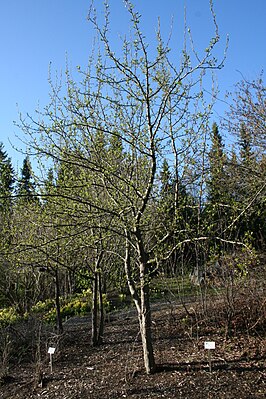Manchurian thorn cherry
| Manchurian thorn cherry | ||||||||||||
|---|---|---|---|---|---|---|---|---|---|---|---|---|

Manchurian thorn cherry ( Prinsepia sinensis ) |
||||||||||||
| Systematics | ||||||||||||
|
||||||||||||
| Scientific name | ||||||||||||
| Prinsepia sinensis | ||||||||||||
| ( Olive. ) Olive. ex Bean |
The Manchurian mandrel cherry ( Prinsepia sinensis ) is a small shrub with yellowish flowers from the family of Rosaceae (Rosaceae). The natural range is in the east of Russia, in China and on the Korean peninsula . The species is sometimes used as an ornamental shrub.
description
The Manchurian Dornkirsche is an approximately 2 meter high, loosely and sparsely growing shrub with gray-green to reddish-brown, thick and bare branches and reddish-brown, angled and bare twigs. The thorns are 6 to 10 millimeters long, leafless and curved. The winter buds are purple-red, egg-shaped and hairy downy. The leaves have a 5 to 10 millimeter long, bare and thin stem. The leaf blade is simple, 3.0 to 6.5 inches long and 0.6 to 2.0 inches wide, ovate-lanceolate, lanceolate or, very rarely, ribbon-shaped, with a pointed, long, pointed or tailed tip, a rounded to broadly wedge-shaped base and removed sawn leaf margin . The upper side of the leaf is dark green with sunken secondary leaf veins , the underside is pale green with protruding veins.
The hermaphroditic flowers are single or in clusters of four flowers in the leaf axils. The bracts are small, membranous, lanceolate and initially fluffy hairy and later balding. The flowers have a diameter of about 1.5 centimeters, the flower stalk is 1.0 to 1.8 centimeters long and glabrous. The flower cup is bell-shaped and bare on the outside. The sepals are triangular-ovate, short, bare on the outside and ciliate on the edges. The five petals are yellow, obovate with a short nailed base and a blunt tip. The ten or so stamens are arranged in two whorls . The ovary is bald, the stylus short. The drupes are purple-red to reddish-brown, round to oblong, glabrous and reach a diameter of 1.0 to 1.5 centimeters. They are tasty.
The Manchurian Dornkirsche blooms from April to May, the fruits ripen from May to September.
The number of chromosomes is 2n = 32.
distribution
The natural range is in the east of Russia in the Primorye region , in China in the provinces Heilongjiang , Jilin , Liaoning and in Inner Mongolia and on the Korean Peninsula . The Manchurian thorn cherry grows in mixed forests, in forests on shady slopes and on river banks on fresh to moist, slightly acidic to alkaline, nutrient-rich soils in sunny to light-shaded, summer-cool locations. The species is usually frost hardy .
Systematics and research history
The Manchurian mandrel Cherry ( Prinsepia sinensis ) is a kind of the genus of prinsepia ( Prinsepia ) in the family of Rosaceae (Rosaceae). There it is assigned to the tribe Osmaronieae in the subfamily Spiraeoideae . The species was first described by Daniel Oliver in 1886 as Plagiospermum sinense ( Basionym ) . William Jackson Bean classified it in 1909 as Prinsepia sinensis in the family of thorn cherries. The generic name Prinsepia is reminiscent of the English archaeologist and colonial administrator James Prinsep (1799-1840), who was the first European to decipher the commandments of the ancient Indian king Ashoka . The specific epithet sinensis refers to the distribution area in China.
use
The Manchurian thorn cherry is sometimes used as an ornamental shrub because of its remarkable fruit decorations .
proof
literature
- Wu Zhengyi, Peter H. Raven, Deyuan Hong (Eds.): Flora of China . Volume 9: Pittosporaceae through Connaraceae . Science Press / Missouri Botanical Garden Press, Beijing / St. Louis 2003, ISBN 1-930723-14-8 , pp. 390 (English).
- Andreas Roloff , Andreas Bärtels: Flora of the woods. Purpose, properties and use. With a winter key from Bernd Schulz. 3rd, corrected edition. Eugen Ulmer, Stuttgart (Hohenheim) 2008, ISBN 978-3-8001-5614-6 , pp. 469-470.
- Jost Fitschen: Woody flora . 12th, revised and expanded edition. Quelle & Meyer, Wiebelsheim 2007, ISBN 3-494-01422-1 , p. 672 .
- Helmut Genaust: Etymological dictionary of botanical plant names. 3rd, completely revised and expanded edition. Nikol, Hamburg 2005, ISBN 3-937872-16-7 (reprint from 1996).
Individual evidence
- ↑ German name after Roloff et al .: Flora der Gehölze , p. 469 and after Fitschen: Gehölzflora , p. 672
- ↑ a b c Prinsepia sinensis in Flora of China , Volume 9, p. 390
- ↑ a b c d Roloff et al .: Flora der Gehölze , pp. 469-470
- ↑ Prinsepia sinensis at Tropicos.org. In: IPCN Chromosome Reports . Missouri Botanical Garden, St. Louis
- ↑ a b Prinsepia sinensis. In: Germplasm Resources Information Network (GRIN). United States Department of Agriculture, accessed May 27, 2012 .
- ↑ D. Potter, T. Eriksson, RC Evans, S. Oh, JEE Smedmark, DR Morgan, M. Kerr, KR Robertson, M. Arsenault, TA Dickinson, CS Campbell: Phylogeny and classification of Rosaceae . Plant Systematics and Evolution, Volume 266, 2007, pp. 5-43. doi : 10.1007 / s00606-007-0539-9
- ↑ Plagiospermum sinense. In: Germplasm Resources Information Network (GRIN). United States Department of Agriculture, accessed May 27, 2012 .
- ↑ Exactly: Etymological Dictionary of Botanical Plant Names , p. 645
- ↑ Exactly: Etymological Dictionary of Botanical Plant Names, pp. 587-588
Web links
Prinsepia sinensis. In: The Plant List. Retrieved May 27, 2012 (English).
